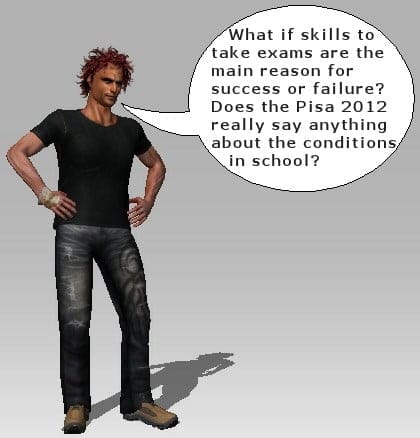 What if skills and engagement to take exams
What if skills and engagement to take exams![]() are the main reason for success or failure? Are really East Asian school-systems that similar to e.g. European that a comparison is possible in concern of reliability and validity? Why are not understanding and creativity measured, but just knowledge-chunks? Math, Science and Reading skills, what about the other subjects? With these questions in mind, does the Pisa International Student Assessment really say anything about the conditions in school? Many politicians think so, they too often use the result as the main source for reform, while loads of research shows that it says very little about what it suppose to measure.
are the main reason for success or failure? Are really East Asian school-systems that similar to e.g. European that a comparison is possible in concern of reliability and validity? Why are not understanding and creativity measured, but just knowledge-chunks? Math, Science and Reading skills, what about the other subjects? With these questions in mind, does the Pisa International Student Assessment really say anything about the conditions in school? Many politicians think so, they too often use the result as the main source for reform, while loads of research shows that it says very little about what it suppose to measure.
Pisa 2012 placement one to six
- Shanghai-China 613
- Singapore 573
- Hong Kong-China 561
- Chinese Tapei 560
- Korea 554
- MacaoChina 538
Unlike USA, Germany, Russia and others that are measured nationwide China has selected some areas that independently are measured. Time Magazine shows that e.g. 84 percent of Shanghai high school graduates go to college compared to 24 percent nationally. The Shanghai result thereby does not say anything about the Chinese knowledge-level in Science, Maths or Reading skills. It is simply the result of “a small minority of elite students”, according to Time Magazine. The other Chinese regions are autonomous or independent and send their own data.
In addition all school-systems of top six are very exam-based, which means that the skills to take exams are trained from very early age with focus on fact-based knowledge. Even the former Prime Minister Wen Jiabao saw this as a problem; he said “…students don’t only need knowledge; they have to learn how to act, to use their brains” (quoted from Time Magazine). In this article with the title “China makes everything. Why can’t it create anything?” by Michael Schuman five reasons are given to why China still struggling to leave the Industrial Society behind. 1. Labour is no longer cheap, which demands that country develop into the post-Industrial Society. 2. Companies lag behind in technology, which means lack of innovation that is the third reason. 4. Too few global brands, the creative process of strategy is lagging behind. 5. Hard to find entrepreneurial managers, educational system despite Pisa 2012 can not fulfil the demands of the post Industrial Society where intrapreneurship and entrepreneurship is very important.
The best educational system in the world
Business Insider described in 27 points why Finland’s unorthodox educational-system is the best in the world. To summarise the advantages the average class-size in Finland is 20 students and the teacher profession has high status and the teachers have autonomy so they fully can use their pedagogical skills. In addition educational philosophy is based on a very broad approach to learning, which makes qualitative individualisation possible. In other words the Finnish teachers are really educational entrepreneurs that work in an environment that makes it possible to form its students for the future life’s realities instead of for the next exam.
In concern of exams in Finland there are no mandatory tests until a single exam at the end of high school. The homework is also very limited. Finnish headmaster Kari Louhivuori explained to Smithsonian “It’s nonsense. We know much more about the children than these tests can tell us.” And no child is left behind, children with learning disabilities or immigrants struggling to learn Finnish are given extra resources but they are all taught in the same classroom.
Pisa 2012 and Finland, Sweden and China
Despite the low amount of exam-training, Finland again performed well with placement 12 on Pisa 2012. It is obvious the Finnish students have the understanding and skills to perform anyway. In this spirit research shows that the Swedish failure in Pisa 2012 depend on that especially low-performing students do much worse than before, middle-performing do to some extent worse, while high-performing is at same level as its counterparts around the world. The reasons for this result can be found in the description of Finland above since Sweden on every point does the opposite.
At the same time the Shanghai elite-schools and city-states at the top of the chart is not really comparable, besides all the other problems that is mentioned above of the Pisa 2012, it is obvious that low-performing countries instead should ask Finland and some others, because they know.
Written by
LarsGöran Boström
Sources
China is Cheating the World Student Ranking System by David Stout, Time.com
China makes everything, why can’t it create anything by Michael Schuman, Time Magazine, November 11, 2013
Pisa 2012 International Student Assessment
Opens in a new tab



